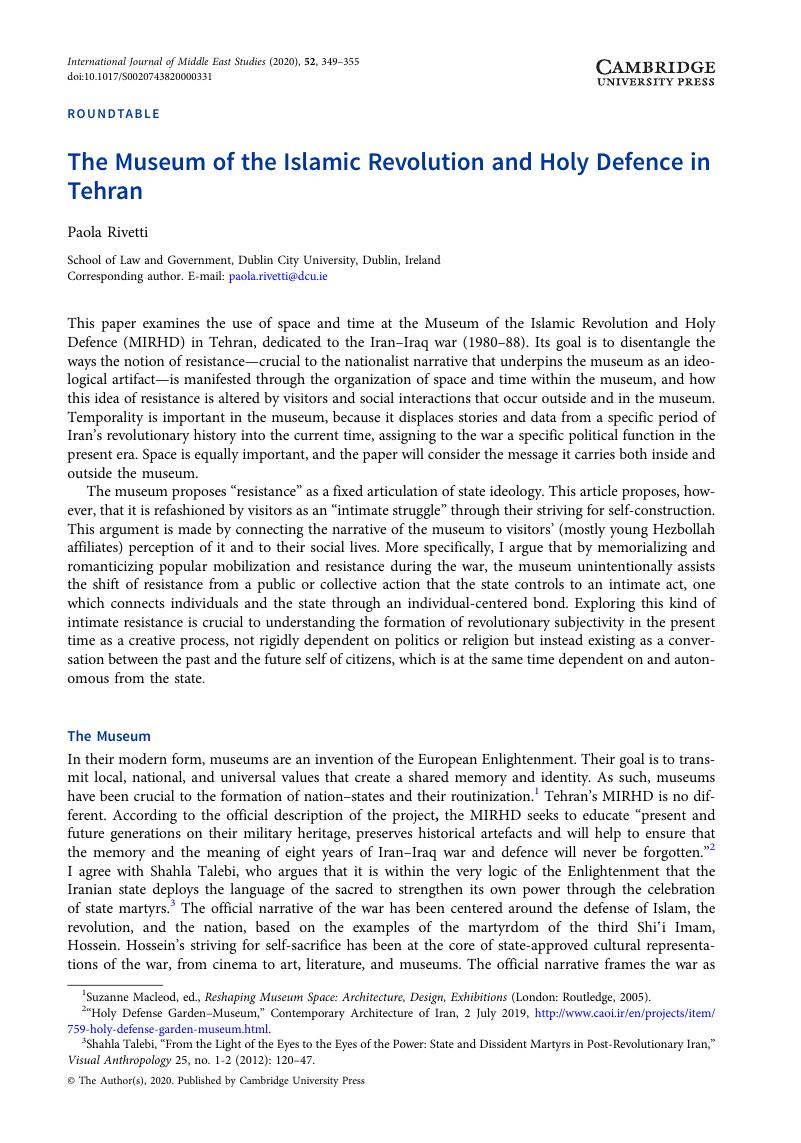No CrossRef data available.
Article contents
The Museum of the Islamic Revolution and Holy Defence in Tehran
Published online by Cambridge University Press: 28 May 2020
Abstract

- Type
- Roundtable
- Information
- Copyright
- Copyright © The Author(s), 2020. Published by Cambridge University Press
References
1 Macleod, Suzanne, ed., Reshaping Museum Space: Architecture, Design, Exhibitions (London: Routledge, 2005)CrossRefGoogle Scholar.
2 “Holy Defense Garden–Museum,” Contemporary Architecture of Iran, 2 July 2019, http://www.caoi.ir/en/projects/item/759-holy-defense-garden-museum.html.
3 Shahla Talebi, “From the Light of the Eyes to the Eyes of the Power: State and Dissident Martyrs in Post-Revolutionary Iran,” Visual Anthropology 25, no. 1-2 (2012): 120–47.
4 Younes Saramifar, “Seeking Light in the Empire of Memory: War Commemorations on Iran's Rahiyan-e Nur,” Ajam Media Collective, 23 September 2019, https://ajammc.com/2019/09/23/empire-of-memory-rahiyan-e-nur.
5 Khorramshahr is a city in southern Iran that was attacked by the Iraqi army at the beginning of the war in 1980. The battle is a symbol of resistance against the Iraqi armed forces. Volunteers came to the city from different areas of the country to fight. The resistance lasted for a month before succumbing to the Iraqi military. Khorramshahr was recaptured by the Iranians two years later.
6 Author interview with the pavilion supervisor, September 2019, Tehran.
7 Mohajeri, Shima, “Louis Kahn's Silent Space of Critique in Tehran, 1973–74,” Journal of the Society of Architectural Historians 74, no. 4 (2015): 485–504CrossRefGoogle Scholar.
8 A number of smaller martyrs’ museums exist in Iran, scattered around the country and independent of each other. This was the first time that a museum (established with the sponsorship of powerful institutions and under their supervision) proposed a consistent and coherent history of the revolution and the holy defense. Although I cannot explore it here, an important issue for future research to address is the reason its establishment took three decades. I thank Alex Baturo for pointing this out to me.
9 The temporal and political discrepancy between the war and the holy defense was emphasized by many of my interlocutors, architects and urban planners whom I interviewed in Tehran in September 2019.
10 Ehsani, Kaveh, “War and Resentment: Critical Reflections on the Legacies of the Iran–Iraq War,” Middle East Critique 26, no. 1 (2017): 5–24CrossRefGoogle Scholar.
11 The foundation was established by Khomeini in 1980 and is funded by the parliament through the national budget law. The foundation is however independent of all elected bodies of the Islamic Republic (the parliament and the presidency of the republic, for instance) and is directly supervised by the supreme leader. It has branches all over the country and provides services ranging from economic support to the distribution of meals to those martyrs’ families and veterans who need it. Khosronejad, Pedram, “Introduction: Unburied Memories,” in Unburied Memories: The Politics of Bodies of Sacred Defense Martyrs in Iran, ed. Khosronejad, Pedram (London: Routledge, 2013), 11–31CrossRefGoogle Scholar.
12 Author interview with one of the architects, September 2019, Tehran.
13 Author interview with multiple architects, who expressed this opinion,
14 Saeidi, Shirin, “Iran's Hezbollah and Citizenship Politics: The Surprises of Religious Legislation in a Hybrid Regime,” in The Middle East in Transition: The Centrality of Citizenship, ed. Butenschøn, Nils A. and Meijer, Roel (Cheltenham, UK: Edward Elgar, 2018), 223–48CrossRefGoogle Scholar.
15 All encounters with visitors and guides took place in the spring of 2019 or in September 2019.
16 Bajoghli, Narges, “The Outcasts: The Start of ‘New Entertainment’ in Pro-Regime Filmmaking in the Islamic Republic of Iran,” Middle East Critique 26 (2017): 61–77CrossRefGoogle Scholar.
17 Gupta, Akhil, “Governing Population: The Integrated Child Development Services Program in India,” in States of Imagination: Ethnographic Explorations of the Postcolonial State, eds. Hansen, Thomas Blom and Finn, Finn Stepputat (Durham, NC: Duke University Press, 2001), 65–96CrossRefGoogle Scholar.
18 Zahra Abbasi and Shirin Saeidi, “Where Do Broken Hearts Go? Martyrs of the Iran–Iraq War and Gendered Contestations over Healing in Contemporary Iran” (working paper, shared with the author, 2019). Abbasi and Saeidi have closely analyzed the contents of the last wills of war martyrs, emphasizing that martyrdom was a highly individualized process through which martyrs healed a variety of personal emotional wounds. Martyrdom, hence, became a personal way to seek reparation and self-construction.
19 This suggestion entails a degree of speculation and calls for further research.




